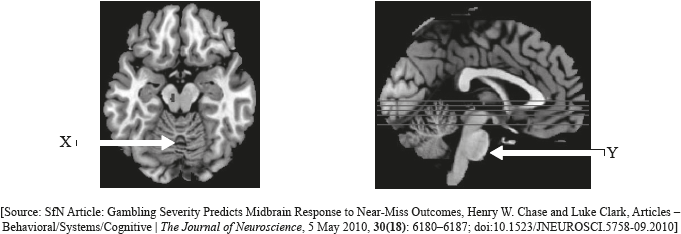| Date | November 2013 | Marks available | 1 | Reference code | 13N.3.HL.TZ0.5 |
| Level | Higher level | Paper | Paper 3 | Time zone | TZ0 |
| Command term | State | Question number | 5 | Adapted from | N/A |
Question
The following images identify brain activity associated with a specific function.

Label the indicated areas on the images.
X:
Y:
State the diagnostic tool used for functional analysis in the images.
Using the table below, distinguish between rod cells and cone cells.

Markscheme
\(\left. {\begin{array}{*{20}{l}} {{\text{X: cerebellum;}}} \\ {{\text{Y: medulla oblongata;}}} \end{array}} \right\}{\text{ (both needed)}}\)
Accept pons/brain stem in place of medulla oblongata
functional magnetic resonance imaging / fMRI
Accept FMRI.

Award [1] for each correct row.
Examiners report
Many candidates labelled the two brain areas correctly, but others provided one or two incorrect answers; the majority identified Y as either the medulla oblongata or the pons and gained the mark, providing that their answer to X was correct. Most had fMRI, but some missed the ‘f’ and did not gain the mark. Most gained marks for the rods and cones, but some marks were not awarded because of imprecise or too vague answers; some candidates answered about colour vision instead of intensity of light. Answers for controlling experiments involving human behaviour were very diverse, but some gained marks for mentioning variations between humans and/or ethics.
Many candidates labelled the two brain areas correctly, but others provided one or two incorrect answers; the majority identified Y as either the medulla oblongata or the pons and gained the mark, providing that their answer to X was correct. Most had fMRI, but some missed the ‘f’ and did not gain the mark. Most gained marks for the rods and cones, but some marks were not awarded because of imprecise or too vague answers; some candidates answered about colour vision instead of intensity of light. Answers for controlling experiments involving human behaviour were very diverse, but some gained marks for mentioning variations between humans and/or ethics.
Many candidates labelled the two brain areas correctly, but others provided one or two incorrect answers; the majority identified Y as either the medulla oblongata or the pons and gained the mark, providing that their answer to X was correct. Most had fMRI, but some missed the ‘f’ and did not gain the mark. Most gained marks for the rods and cones, but some marks were not awarded because of imprecise or too vague answers; some candidates answered about colour vision instead of intensity of light. Answers for controlling experiments involving human behaviour were very diverse, but some gained marks for mentioning variations between humans and/or ethics.

